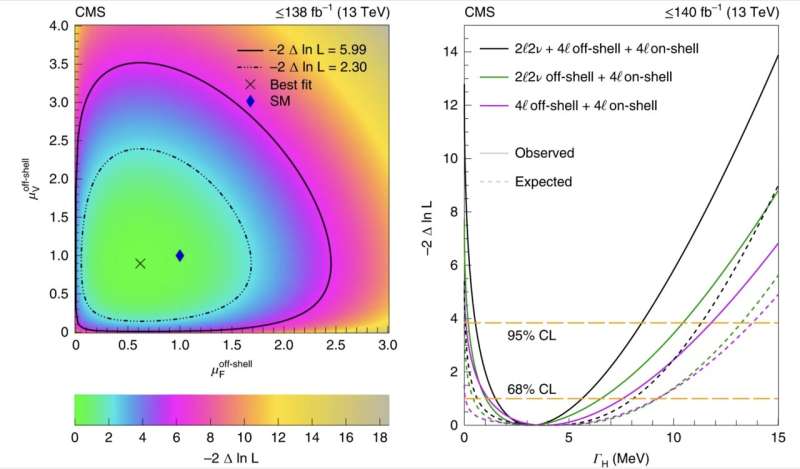November 25, 2022 feature
Evidence of Higgs boson contributions to the production of Z boson pairs at high energies

The Higgs boson, the fundamental subatomic particle associated with the Higgs field, was first discovered in 2012 as part of the ATLAS and CMS experiments, both of which analyze data collected at CERN's Large Hadron Collider (LHC), the most powerful particle accelerator in existence. Since the discovery of the Higgs boson, research teams worldwide have been trying to better understand this unique particle's properties and characteristics.
The CMS Collaboration, the large group of researchers involved in the CMS experiment, has recently obtained an updated measurement of the width of the Higgs boson, while also gathering the first evidence of its off-shell contributions to the production of Z boson pairs. Their findings, published in Nature Physics, are consistent with standard model predictions.
"The quantum theoretical description of fundamental particles is probabilistic in nature, and if you consider all the different states of a collection of particles, their probabilities must always add up to 1 regardless of whether you look at this collection now or sometime later," Ulascan Sarica, researcher for the CMS Collaboration, told Phys.org. "When analyzed mathematically, this simple statement imposes restrictions, the so-called unitarity bounds, on the probabilities of particle interactions at high energies."
Since the 1970s, physicists have predicted that when pairs of heavy vector bosons Z or W are produced, typical restrictions at high energies would be violated, unless a Higgs boson was contributing to the production of these pairs. Over the past ten years, theoretical physics calculations showed that the occurrence of these Higgs boson contributions at high energies should be measurable using existing data collected by the LHC.
"Other investigations have shown that the total decay width of the Higgs boson, which is inversely proportional to its lifetime and predicted in the standard model to be notably very small (4.1 mega-electron volts in width, or 1.6×10-22 seconds in lifetime) can be determined using these high-energy events at precision at least a hundred times better than other techniques limited by detector resolution (1000 mega-electron volts in total width measurements, and 1.9×10-13 seconds in lifetime measurements)," Sarica explained.
"For these reasons, our paper had two objectives: to look for the presence of Higgs boson contributions to heavy diboson production at high energies, and to measure the Higgs boson total decay width as precisely as possible via these contributions."
As part of their recent study, the CMS collaboration analyzed some of the data collected between 2015 and 2018, as part of the second data collection run of the LHC. They specifically focused on events characterized by the production of pairs of Z bosons, which subsequently decayed into either four charged leptons (i.e., electrons or muons) or two charged leptons and two neutrinos.
Past experimental analyses suggest that these two unique patterns are the most sensitive to the production of heavy pairs of bosons at high energies. By analyzing events that matched these patterns, therefore, the team hoped to gather clearer and more reliable results.
"We observed the first evidence of the Higgs boson contributions in the production of Z boson pairs at high energies with a statistical significance of more than 3 standard deviations," Li Yuan, another member of the CMS collaboration, told Phys.org. "The result strongly supports the spontaneous electroweak symmetry breaking mechanism, which preserves unitarity in heavy diboson production at high energies."
In addition to gathering evidence of Higgs boson contributions to ZZ production, the CMS collaboration was able to significantly improve existing measurements of the Higgs boson's total decay width or lifetime. The measurement they collected was believed to be unattainable 10 years ago, given the narrow width of the particle (i.e., 4.1 mega-electron volts according to predictions from the standard model of particle physics).
"Our result for this measurement is 3.2 mega-electron volts with an upper error of 2.4 mega-electron volts and a lower error of 1.7 mega-electron volts," Yuan said. "This result is consistent with the standard model expectation so far, but there is still room that a future measurement with even greater precision could deviate from the prediction."
The recent work by the CMS collaboration offers new insight about the properties of the Higgs boson, while also highlighting its contribution to the production of Z boson pairs. In their next studies, the researchers plan to continue their exploration of this fascinating subatomic particle using new data collected at the LHC and advanced analysis techniques.
"While our results have reached a statistical significance beyond the threshold of 3 standard deviations, typically taken as evidence in the particle physics community, more data is needed to be able to reach the threshold of 5 standard deviations in order to claim a discovery," Sarica said.
The third data collection run of the LHC started this year and is expected to continue until the end of 2025. Sarica, Yuan, and the rest of the CMS collaboration have already started preparations that will allow them to measure the Higgs boson's width with even greater precision using the new data collected as part of this third round of data collection.
"In addition, our CMS analysis does not yet include the analysis of high-energy events with four charged leptons from the 2018 data, and preparations are ongoing for its inclusion in an update," Sarica added.
"Recent preliminary results from the ATLAS Collaboration, showcased on Nov. 9 during the Higgs 2022 conference, also provide an independent confirmation of the evidence CMS finds, so once their results go through peer-review, we hope the two collaborations can discuss how the two analyses can be combined to provide the best measurements of Higgs boson contributions at high energy and its total width."
More information: The CMS Collaboration , Measurement of the Higgs boson width and evidence of its off-shell contributions to ZZ production, Nature Physics (2022). DOI: 10.1038/s41567-022-01682-0
Conference: indico.cern.ch/event/1086716/
Journal information: Nature Physics
© 2022 Science X Network





















